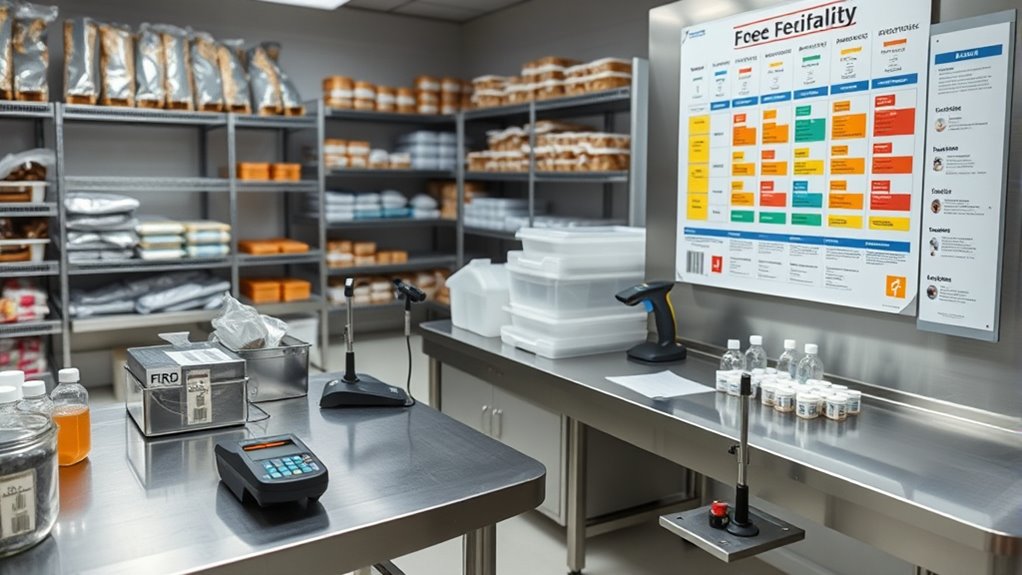When managing a food recall, you should quickly detect contamination through inspections or lab tests and confirm its scope. You then follow your recall plan to isolate affected products and notify consumers clearly via multiple channels, including social media and helplines. Good recordkeeping guarantees traceability and accountability. Efficient recall processes protect public health, maintain trust, and reduce legal risks. Appreciating these steps will help you understand how effective traceability supports swift, safe food recall actions.
Key Takeaways
- Implement contamination detection methods such as inspections and lab tests to identify and confirm safety issues promptly.
- Develop a comprehensive recall plan outlining roles, communication channels, and procedures to isolate affected products.
- Notify consumers through multiple channels with clear information about hazards and recommended actions, supported by a helpline.
- Maintain detailed records of contamination scope, distribution, notifications, and corrective actions for traceability and accountability.
- Ensure water safety standards are integrated into recall protocols to improve safety measures and prevent future contamination.

When a food safety issue is identified, swift and effective recall procedures are essential to protect consumers and minimize health risks. The process begins with contamination detection, which involves thorough testing and monitoring of the food supply chain. As soon as a potential problem is flagged—whether through routine inspections, laboratory analysis, or consumer reports—you need to act quickly to confirm the issue. Precise contamination detection helps determine the severity and scope of the problem, guiding your next steps. Once contamination is confirmed, you must initiate a recall plan that clearly outlines roles, responsibilities, and communication channels. This plan should include detailed procedures for isolating affected products, preventing further distribution, and verifying the extent of contamination. The goal is to contain the problem efficiently before it spreads further into the supply chain.
Consumer notification is a critical component of a successful recall. When you identify a contaminated product, informing the public promptly is imperative to prevent health risks. You should develop clear, transparent messages that specify which products are involved, the potential hazards, and the steps consumers should take—such as returning the product or discarding it. Using multiple communication channels enhances the reach and effectiveness of your notification. These channels could include press releases, social media updates, direct notices on retail websites, and notifications through health agencies. Making sure consumers have easy access to information and understand the urgency of the situation helps minimize exposure to contaminated products. Additionally, you should establish a dedicated helpline or customer service team to handle inquiries and provide guidance. Maintaining a comprehensive record of all communications is also crucial for traceability and accountability.
Throughout the recall process, maintaining detailed records is essential. Documentation should include the scope of contamination, distribution records, consumer notifications, and any corrective actions taken. This traceability ensures accountability and facilitates future audits or investigations. It also supports effective follow-up, such as verifying that contaminated products have been removed from the market. When you manage contamination detection and consumer notification efficiently, you’re not only protecting public health but also maintaining trust in your brand. Transparency and prompt action demonstrate your commitment to safety, which can mitigate reputational damage and legal liabilities. Remember, a well-coordinated recall process, grounded in accurate detection and clear communication, is your best defense against food safety crises and ensures the well-being of your consumers. Incorporating water safety standards can further enhance your safety protocols and prevent contamination issues.
Frequently Asked Questions
How Often Are Food Recall Procedures Reviewed and Updated?
You should review and update your recall schedule and procedures at least annually to guarantee effectiveness. Regular reviews help identify gaps and adapt to new regulations or industry standards. Additionally, after any recall incident, you must promptly update your procedures to improve response times and accuracy. Staying proactive with procedure updates keeps your recall process reliable, minimizes risks, and maintains consumer trust.
What Technologies Assist in Tracking Food Product Origins?
You can use blockchain verification and RFID tracking to effectively trace food product origins. Blockchain provides a secure, transparent ledger that records each step of the supply chain, making it easy to validate authenticity. RFID tracking uses radio-frequency identification tags to monitor product movement in real-time. Together, these technologies enhance traceability, allowing you to quickly identify sources and ensure food safety throughout the supply chain.
How Do Companies Handle Customer Notifications During Recalls?
During recalls, you should prioritize customer communication by promptly informing customers through multiple channels like email, social media, and press releases. You handle notifications with recall transparency, clearly explaining the issue, steps to address it, and how customers can respond. This approach builds trust and reassures your customers that you’re committed to their safety. Always provide accessible contact information and updates to guarantee effective and transparent communication throughout the recall process.
Are There International Standards for Food Traceability Systems?
Did you know that over 80% of countries are adopting international standards for traceability systems? Yes, there are global standards that help guarantee consistency and safety across borders. These standards, like those from the Codex Alimentarius, provide guidelines for traceability systems, making it easier for companies to track products worldwide. Following these international standards helps you improve food safety, comply with regulations, and build consumer trust.
What Training Is Provided to Staff on Recall Protocols?
You receive thorough training on recall protocols, including regular recall simulations to guarantee staff readiness. This training emphasizes staff compliance with recall procedures, teaching you how to quickly identify affected products, communicate with stakeholders, and execute recall steps effectively. By participating in these simulations, you build confidence and stay prepared, ensuring swift action during an actual recall, which helps protect consumers and maintain your company’s reputation.
Conclusion
By understanding and following proper food recall procedures and traceability, you guarantee consumer safety and trust. Are you prepared to act swiftly and accurately if a recall becomes necessary? Remember, keeping detailed records and having clear procedures in place makes all the difference in protecting public health. When every second counts, can you see how your proactive steps create a safer, more transparent food supply for everyone?








